June 14th, 2007
tempeh trials
The tempeh story:
Once upon a time there was a girl who thought tempeh came from a magical place and underwent a laborious process in which fairies danced and chanting was necessary for the tempeh to be produced and brought to market.
This girl revered her tempeh for its nutritional content, tastiness and versatility. She wanted to showcase it as her entree protein at culinary school to show the meat hungry savages that there IS another way to eat and honor one’s body. A teacher who once brought her to tears with his criticism encouraged this girl to make it from scratch, thus showing her alt-charcuterie skills. And so begins the journey that is tempeh. May the fairies continue to bless the soybeans as they undergo fermentation.
- Soak 1 lb. whole soybeans overnight OR bring beans and enough water to cover to a boil. Boil for 20 minutes and then soak for 2 hours. Drain beans of soaking water.
- Hand de-hull the beans by rubbing them vigorously between your hands OR pulse beans in a food processor until the majority of the beans have been split. I recommend hand de-hulling if you have a wraparound porch with a nice view or good company.
- Transfer beans to a large pot and cover with enough cold water to cover the beans by 2 inches.
- Bring the beans to a boil. Do not go to the store or fall asleep. The hulls will come to the surface with much force. Skim off as much of the hulls as you want to. The more hulls, the more fiber (but the texture will change a bit).
- Boil the beans for 40 minutes. While this is happening, prepare your incubation buddy. A zip-lock bag will work just fine (a gallon bag is good for 1 lb of beans). Poke holes (I used my digital thermometer point but anything pointy will work) about 1/2″ apart all over the bag. The bacteria needs air to breathe!
- Drain the water from the cooked beans and spread them out onto a pan covered with a CLEAN towel. Cover with another towel and dry the beans well until they are “body temperature and skin dry.” (about 10 minutes)
- Transfer beans to a bowl and sprinkle the bacteria starter (I used 1 tsp starter from GEM per pound of dry beans).
- Spoon the bean-bacteria mixture into the zip-lock bag and pack it nicely so that the beans can easily become bound. (I like to make the tempeh about 1/2″ thick).
- Place directly on the rack of a gas oven, in the middle. Prop the oven open with an apron or towel. The ideal temperature is 85-88 deg F. Check the temperature as often as you can. It is important that the first 12 hours the tempeh has an ambient temp of 85 deg. After that, the bacteria starts producing its’ own heat and can be moved if necessary.
- My tempeh was done after 22 hours, but the oven temp was hotter than ideal. Incubate 22-28 hours, until done.
“Done” tempeh is: firmly bound beans with white mycelium and smells mushroomy and fresh. Black/gray spots are okay. It should not smell like ammonia. Slice it, a thin slice should hold together rather well. If it is not ready, keep incubating it up to 36 hours total. If it crumbles or smells like garbage, throw it out and start again. My large batch wasn’t cohesive at the corner closest to the pilot light, so I cut that portion out and incubated it longer.
11. Wrap in plastic and refrigerate to kill the bacteria. Do not stack the tempeh until it has reached 41 degrees, or it will continue to ferment at contact points.
It will last 5 days in the fridge (though I’ve eaten it after a week) and apparently forever in the freezer.
Uses: sliced and fried, marinated and fried/baked for snacks, sandwiches; cubed for stir-fries, grated and simmered in marinara sauces and basically anywhere you want to add it. Most people recommend steaming the tempeh for 20 minutes before cooking it to de-activate the bacteria, but I don’t really do that step. My instructor at school took a bite of the tempeh while it was fermenting and he survived…I think you just need to be prepared for your stomach to potentially act up if it’s not used to bacteria. I’m a bit lazy and just make sure I cook it. My favorite way to achieve juicy, flavorful tempeh is to marinate it overnight in a mixture of water, soy sauce, maple syrup, garlic and ginger, then bake it for 60 minutes at 350 deg F. I cool it and use it for whatever (bread and fry, slice for tlt’s, etc.) Store any unused portions in the marinade for up to a week.

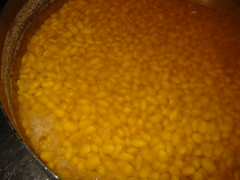
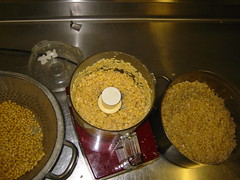
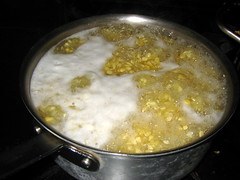
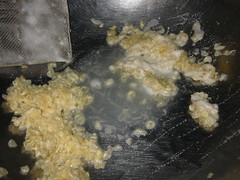
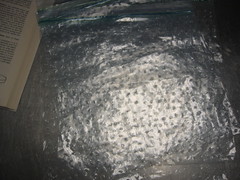
September 26th, 2008 at 1:45 pm
Cool! I can’t wait to make this. Thanks for posting the recipe. I just wanted to ask, do you wrap the bean/bacteria mixture in foil and then put it in the ziplock (in the picture it looks like there’s foil or something)? Also, the lowest setting on my gas oven is 200 degrees. Do you think that propped open with a towel it would stay around 85 (I wouldn’t want the plastic ziplock to melt)? Finally, do you just do it in the oven for 12 hrs and then take it out for the remaining 10 hrs, or do all 22 hrs in the oven? I don’t know how I would keep the oven on for 22 hrs, and I even wonder if having it propped open for 12 hrs would make my apartment explode. Thank you for addressing these paranoid questions if you have time!
September 30th, 2008 at 12:54 pm
I don’t wrap it in foil, the ziplocks were just on top of a stainless surface. I packed the bean mixture straight into ziplocks and pressed it into the shape and put it on a wire rack so there is airflow all around. Don’t wrap it with foil because the bacteria need the air to grow. I have finished pictures of the tempeh on another blog post here.
Most gas ovens propped open will be about 85 degrees. The pilot keeps it toasty. You can test it with an oven thermometer. I wouldn’t bother turning it on unless you have an electric oven. In that case, turn it on to the lowest setting, then shut it off. You don’t want the oven hotter than 88 degrees F. You may need to turn the electric oven on and off in a few hours to keep it warm.
I keep the tempeh in the oven for the full 22 hours to incubate. It may take more or less, depending on the freshness of the bacteria and your soybeans. Your apartment won’t explode. The oven shouldn’t be on, the pilot light is enough to keep the tempeh at the right temperature.
Good luck and let me know how it turns out! Contact me if you have more questions.
October 10th, 2008 at 6:30 am
THANK YOU!!! Now it all makes sense and I can’t wait to try. It never occurred to me that the oven didn’t have to be turned on! Thanks again. I’ll report back on my magical tempeh adventure.
October 13th, 2008 at 7:09 pm
I’ll look forward to it. Good luck and enjoy!
June 22nd, 2010 at 11:53 pm
I’m Indonesian origin and tempe (we spell that way ) was daiy life back then. Moved abroad and found no tempe has been couraged me to actually try to make it myself. Unfortunatelly, so far been failed
) was daiy life back then. Moved abroad and found no tempe has been couraged me to actually try to make it myself. Unfortunatelly, so far been failed  After I read this, I just realised that making tempe is not easy than I thought. I’ve been wondering why I was failing over and over again. Now I know, I probably got the temparature wrong. It was too hot! So, if the temparature is above 30 degree c, what should I do? Where should I keep the tempe?
After I read this, I just realised that making tempe is not easy than I thought. I’ve been wondering why I was failing over and over again. Now I know, I probably got the temparature wrong. It was too hot! So, if the temparature is above 30 degree c, what should I do? Where should I keep the tempe?
My friends told me, how lucky they are to not have to make one and it’s very cheap in Indonesia
Thank you
June 23rd, 2010 at 11:39 am
I’m sorry you’re having problems getting the tempe to ferment correctly. Are you using enough bacteria? I find the most likely problem is temperature, too cold or too hot. Where and how are you incubating your tempe? I have no problems with the perforated ziplock on a cooling rack in the oven. If yours is getting over 30 deg C, I’d try to move it to a different location (not on top of the fridge or in the oven, perhaps a basement? maybe start your first 12 hours in the evening when it is cooler outside?) After a few hours I tend to stick a thermometer in the tempe cake to get an idea of where it’s at. Good luck, let me know how it goes!
June 23rd, 2010 at 8:35 pm
I did actually put them on top of the fridge last time Thank you for the tips…I will try again and let you know.
Thank you for the tips…I will try again and let you know.